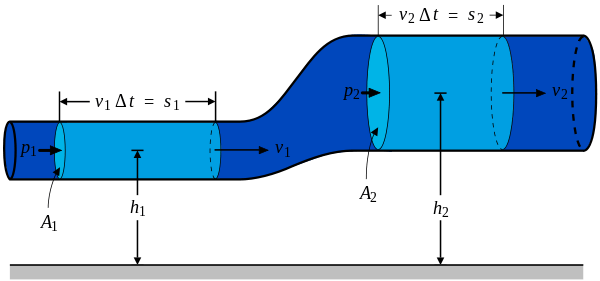Newtonian fluid
In continuum mechanics, a Newtonian fluid is a fluid in which the viscous stresses arising from its flow, at every point, are linearly[1] proportional to the local strain rate—the rate of change of its deformation over time.[2][3][4] That is equivalent to saying that those forces are proportional to the rates of change of the fluid's velocity vector as one moves away from the point in question in various directions.
More precisely, a fluid is Newtonian only if the tensors that describe the viscous stress and the strain rate are related by a constant viscosity tensor that does not depend on the stress state and velocity of the flow. If the fluid is also isotropic (that is, its mechanical properties are the same along any direction), the viscosity tensor reduces to two real coefficients, describing the fluid's resistance to continuous shear deformation and continuous compression or expansion, respectively.
Newtonian fluids are the simplest mathematical models of fluids that account for viscosity. While no real fluid fits the definition perfectly, many common liquids and gases, such as water and air, can be assumed to be Newtonian for practical calculations under ordinary conditions. However, non-Newtonian fluids are relatively common, and include oobleck (which becomes stiffer when vigorously sheared), or non-drip paint (which becomes thinner when sheared). Other examples include many polymer solutions (which exhibit the Weissenberg effect), molten polymers, many solid suspensions, blood, and most highly viscous fluids.
Newtonian fluids are named after Isaac Newton, who first postulated the relation between the shear strain rate and shear stress for such fluids in differential form.
Definition
An element of a flowing liquid or gas will suffer forces from the surrounding fluid, including viscous stress forces that cause it to gradually deform over time. These forces can be mathematically approximated to first order by a viscous stress tensor, which is usually denoted by .
The deformation of that fluid element, relative to some previous state, can be approximated to first order by a strain tensor that changes with time. The time derivative of that tensor is the strain rate tensor, that expresses how the element's deformation is changing with time; and is also the gradient of the velocity vector field at that point, often denoted .
The tensors and can be expressed by 3×3 matrices, relative to any chosen coordinate system. The fluid is said to be Newtonian if these matrices are related by the equation where is a fixed 3×3×3×3 fourth order tensor, that does not depend on the velocity or stress state of the fluid.
Incompressible isotropic case
For an incompressible and isotropic Newtonian fluid, the viscous stress is related to the strain rate by the simpler equation
where
- is the shear stress ("drag") in the fluid,
- is a scalar constant of proportionality, the shear viscosity of the fluid
- is the derivative of the velocity component that is parallel to the direction of shear, relative to displacement in the perpendicular direction.
If the fluid is incompressible and viscosity is constant across the fluid, this equation can be written in terms of an arbitrary coordinate system as
where
- is the th spatial coordinate
- is the fluid's velocity in the direction of axis
- is the th component of the stress acting on the faces of the fluid element perpendicular to axis .
One also defines a total stress tensor ) that combines the shear stress with conventional (thermodynamic) pressure . The stress-shear equation then becomes
For anisotropic fluids
More generally, in a non-isotropic Newtonian fluid, the coefficient that relates internal friction stresses to the spatial derivatives of the velocity field is replaced by a nine-element viscosity tensor .
There is general formula for friction force in a liquid: The vector differential of friction force is equal the viscosity tensor increased on vector product differential of the area vector of adjoining a liquid layers and rotor of velocity:
where – viscosity tensor. The diagonal components of viscosity tensor is molecular viscosity of a liquid, and not diagonal components – turbulence eddy viscosity.[5]
Examples
Water, air, milk, alcohol, glycerol, and thin motor oil are examples of (practically) Newtonian fluids that have different density properties, which allows a different shear stress and rate flow graphs within a given interval.
See also
| Continuum mechanics | ||||
|---|---|---|---|---|
 | ||||
|
Laws
|
||||
References
- ↑ Panton, Ronald L. (2013). Incompressible Flow (Fourth ed.). Hoboken: John Wiley & Sons. p. 114. ISBN 978-1-118-01343-4.
- ↑ G. K. Batchelor (2000) [1967]. An Introduction to Fluid Dynamics. Cambridge Mathematical Library series, Cambridge University Press. ISBN 0-521-66396-2.
- ↑ Kundu P and Cohen I. Fluid Mechanics.
- ↑ Kirby, B.J. (2010). Micro- and Nanoscale Fluid Mechanics: Transport in Microfluidic Devices. Cambridge University Press. ISBN 978-0-521-11903-0.
- ↑ A. N. Volobuev (2012). Basis of Nonsymmetrical Hydromechanics. Nova Science Publishers, Inc. New York. ISBN 978-1-61942-696-2.